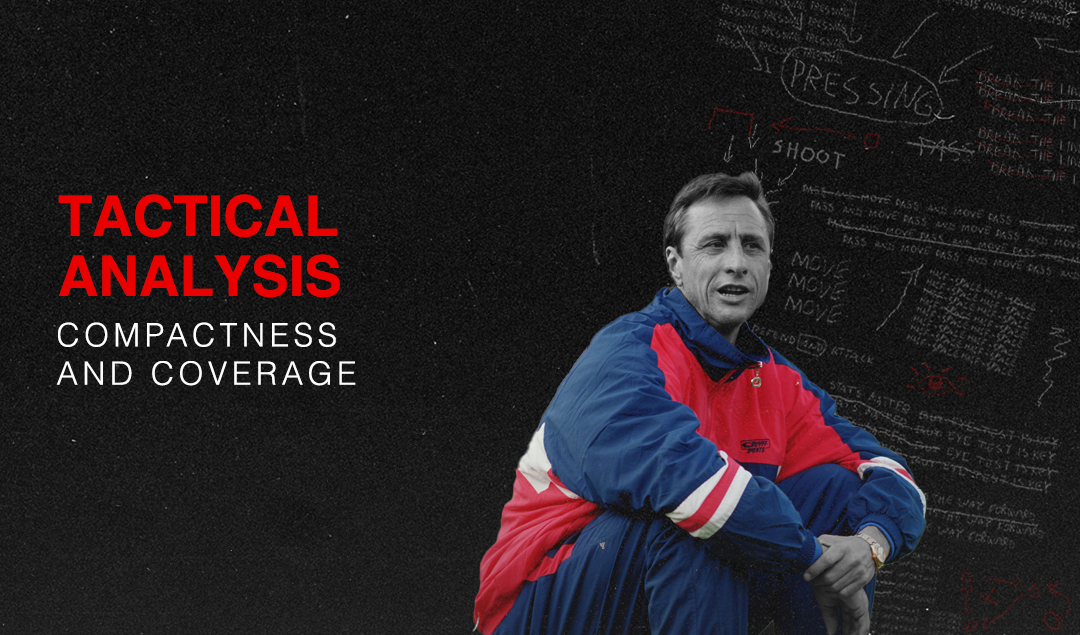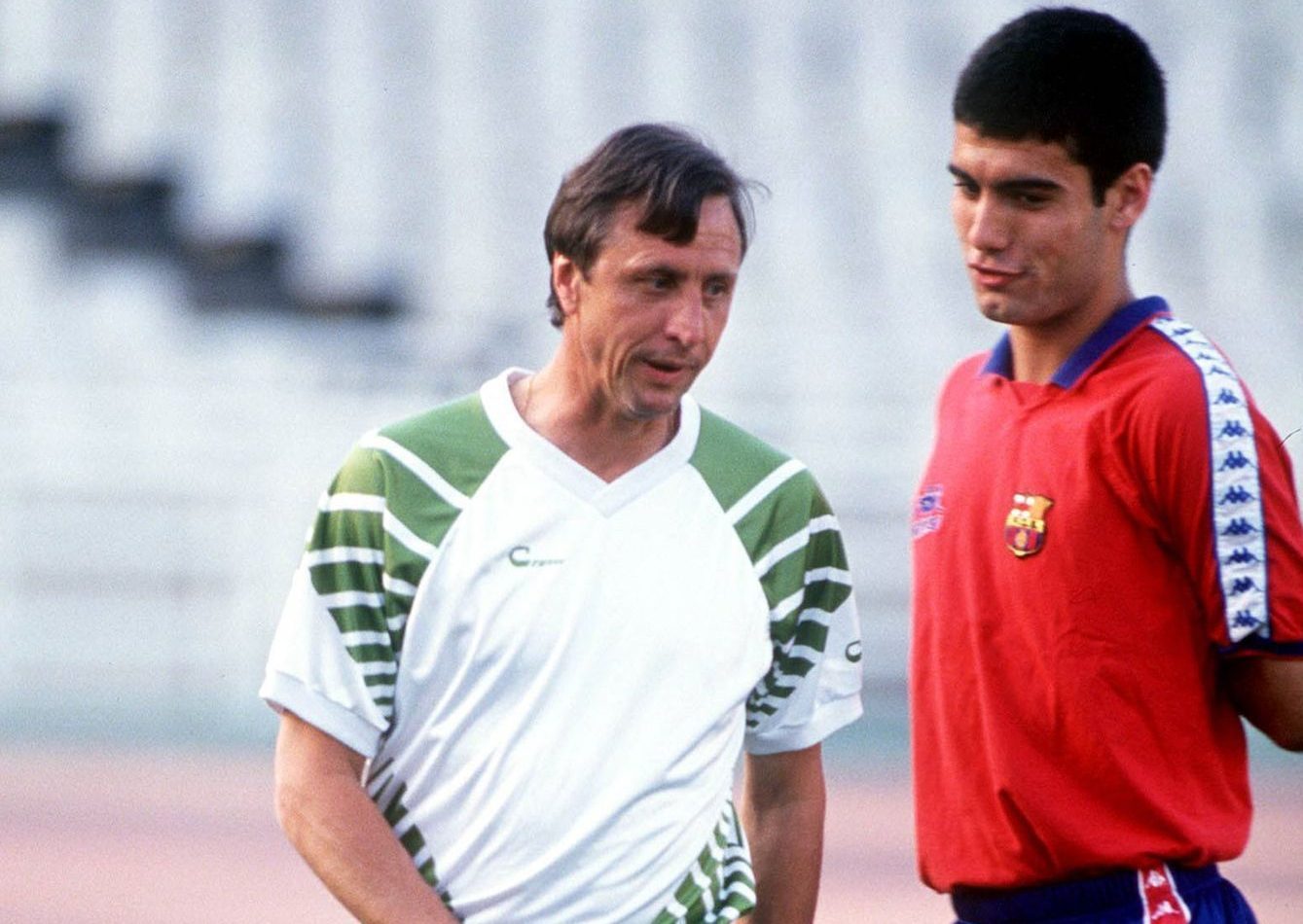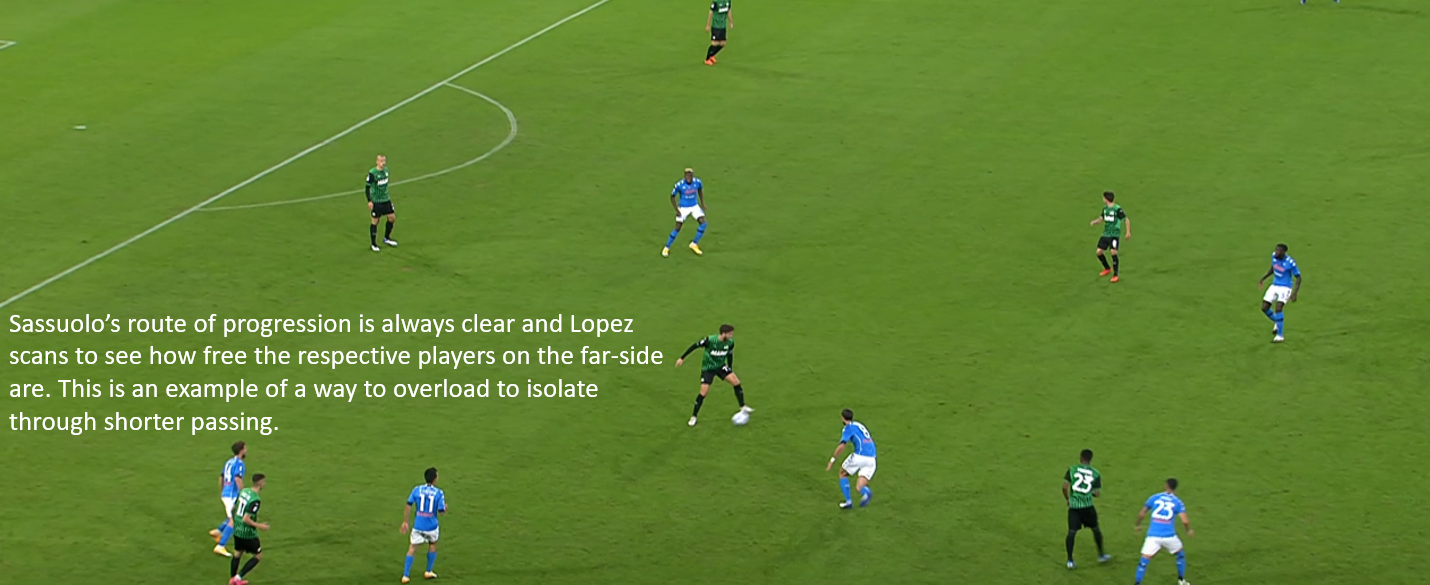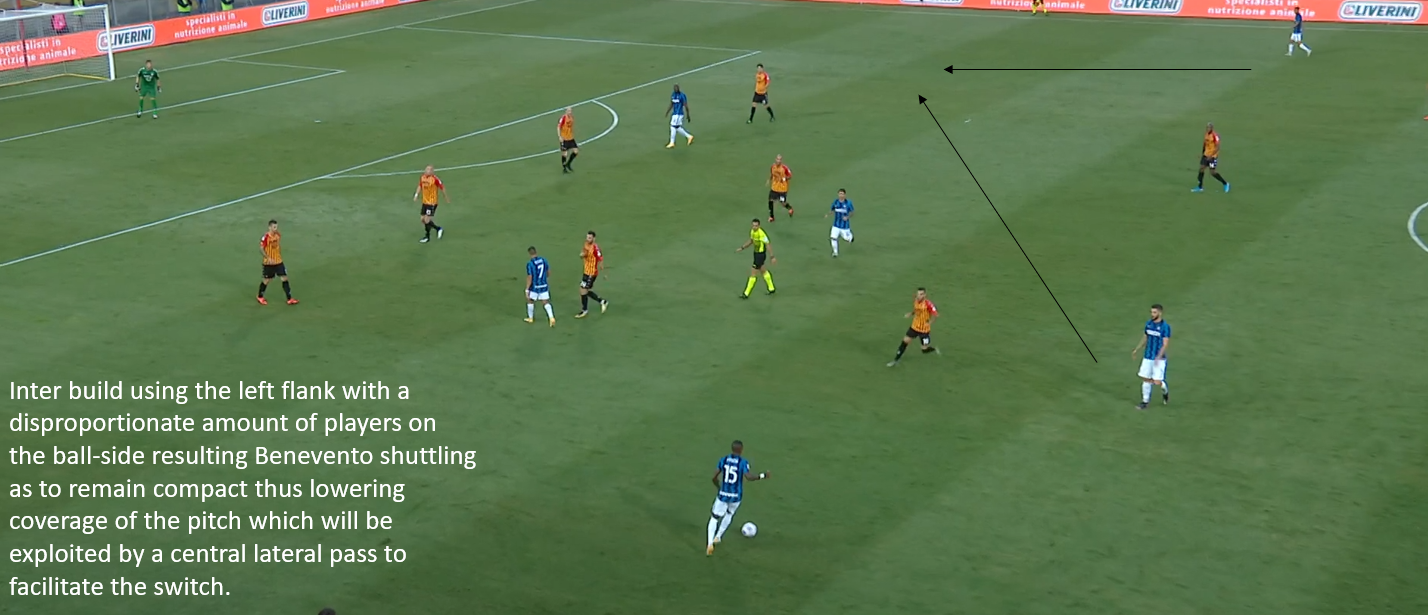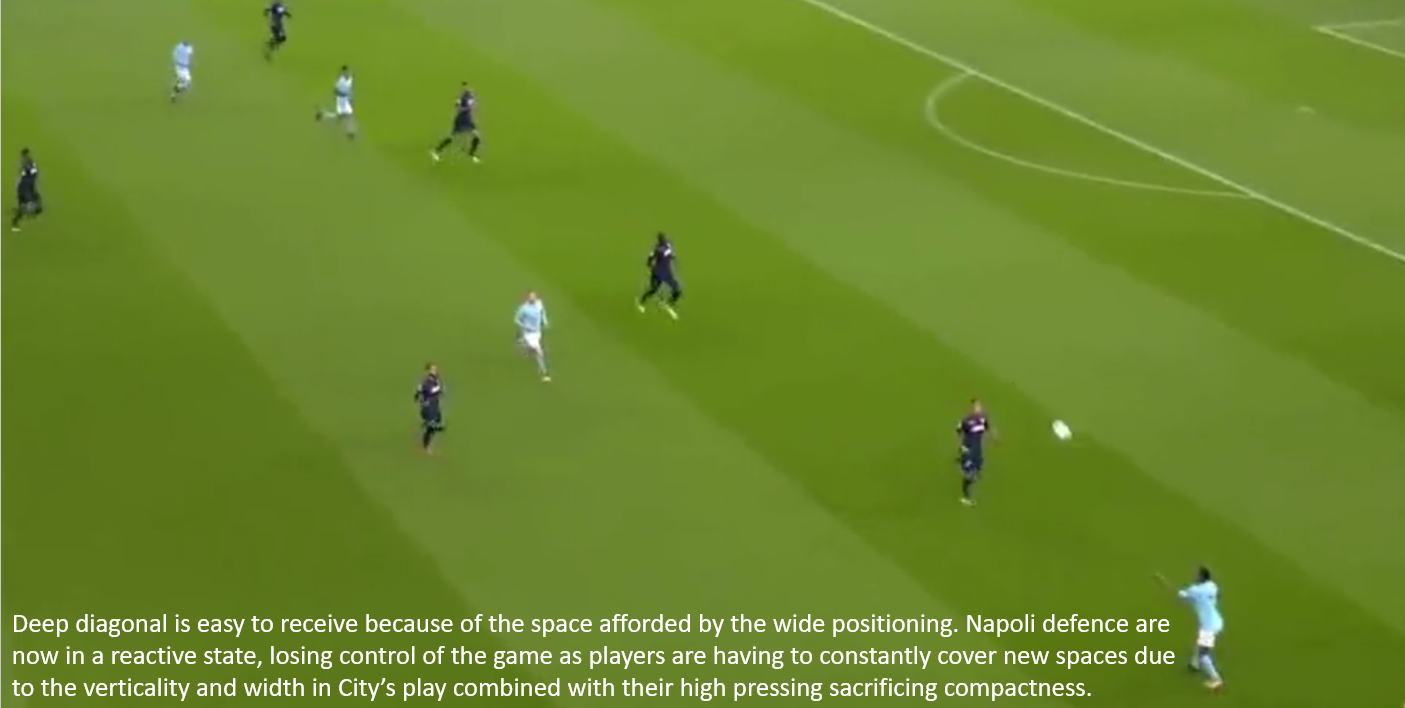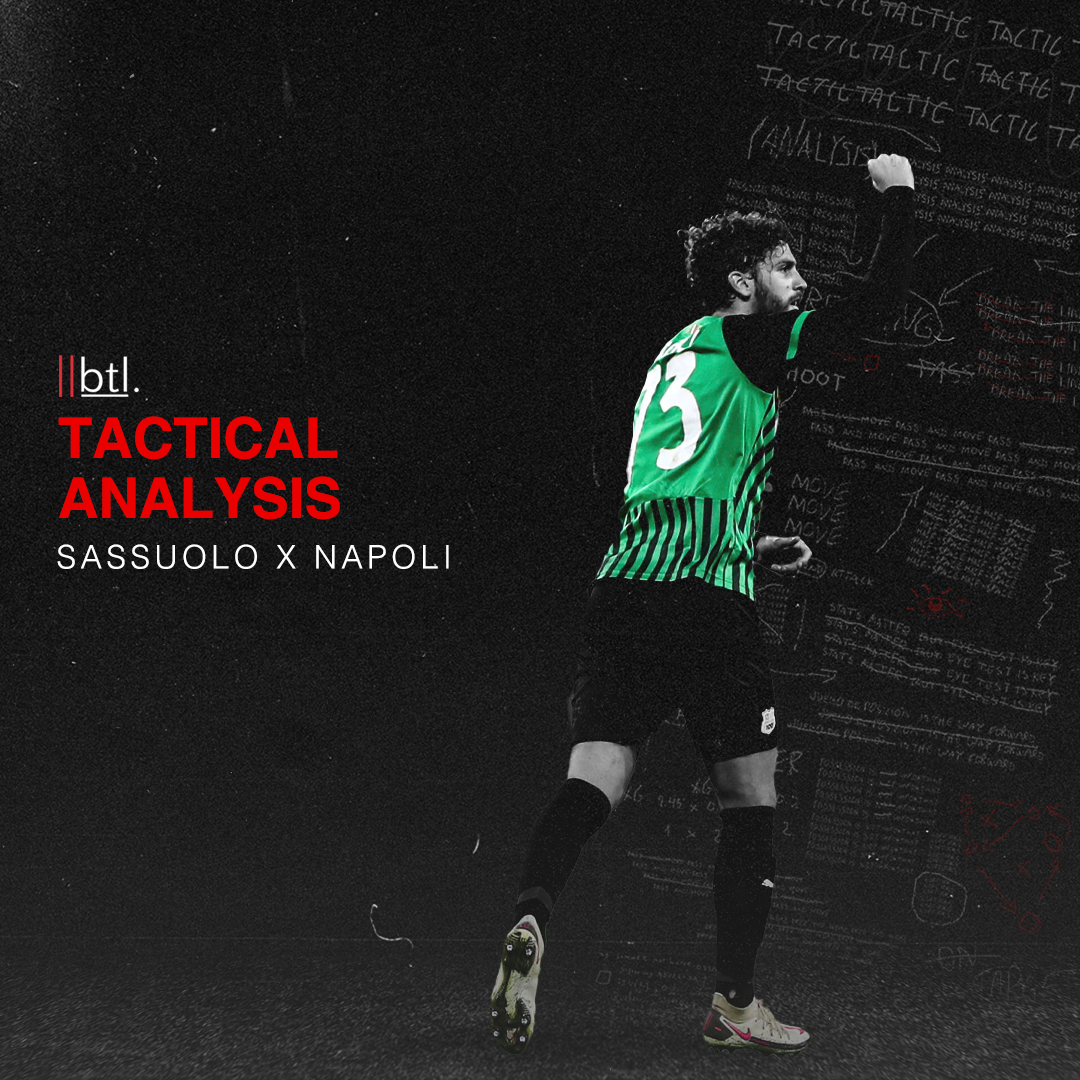Tactical Analysis: Compactness and Coverage in Possession
The most cited quotation in tactical theory can be attributed to Johan Cruyff, who once said, “If you have the ball you must make the field as big as possible, and if you don’t have the ball you must make it as small as possible.”
This is for good reason, as it encapsulates a conceptualisation of football predicated on space. The wider the pitch is in possession, the greater the extent the opponent must cover, or else space is allowed for a player to receive possession. By increasing defensive coverage of width, a team must sacrifice space elsewhere, as the quantity of players is finite and therefore to increase coverage they must consequently reduce compactness.
A back five for instance provides great coverage of width while remaining compact through adding an additional player to a conventional back four set-up. However, it is more difficult to pressure the opposition higher up and thus territory is ceded meaning more of the play will occur in the final third because a midfield three without support of wingers cannot cover the extent of the second line and lone striker cannot effectively press a backline thus support from wingers is required which cedes space which cannot be covered by a midfield two.
As such, it is common for instance for teams playing a 5-3-2 to defend in a 4-4-2 in the middle third with the ball-sided wing back pushing forward as to maintain good coverage and compactness in the midfield. This is not to say playing a back five is wrong but rather the defending of space is predicated on a series of trade-offs whereby certain zones must be prioritized in relation to the ball.
These trade-offs can thus be conceptualised as a compactness or coverage conundrum whereby to achieve a greater element of either you must consequently sacrifice another, with this rationale being applicable in both a horizontal and vertical sense. For instance, playing a high line increases vertical compactness but reduces vertical coverage of the space in behind, and accordingly engaging in deeper regions of the pitch increases vertical compactness but reduces vertical coverage in the opponent’s third and beyond.
There is however an element of differentiation between space in the nominal sense which remains constant and space in the effective sense, which refers to space accessible through passing, dribbling or other actions in the moment. And this effective space is what Cruyff refers to, players cannot in any literal sense make the pitch bigger or smaller, they can however in the effective sense.
Photo: Rex Features
By compacting the pitch through engaging in a touchline press for instance, the effective space is limited as the player in possession is constrained in the directions he can pass. Through playing a perfect offside trap or high line, the space in behind is made ineffective thus allowing compactness to be achieved without sacrificing coverage. Although, the operative word is perfect as in a practical sense it is always penetrable.
The methods by which is achieved in the offensive sense is varied, but positional play is perhaps the footballing philosophy which puts the greatest emphasis on coverage of space in possession as to maximise the size effective pitch through the use of vertical corridors whereby the full extents of the pitch can be reached through a series of quick actions, either determined or spontaneous within the structure where one action implies another.
Thierry Henry articulates this excellently in the documentary “Take the Ball, Pass the Ball” (37:40 – 38:41) he explains that he stayed on the touchline to allow Andrés Iniesta to receive the ball in the half-space with more time, and/or alternatively made a decoy run which stretches the pitch vertically and occupies the attention of a defender as to allow Iniesta in this example greater time in possession.
Thus, there is a relationship between horizontal stretching and territory gained as it creates space for reception of which progressive options are contained or progression via dribbling. How it manifests itself varies depending on the opposition reacting to the coverage/compactness conundrum. Should they seek to prevent the wide player receiving the ball, they sacrifice compactness in midfield allowing for the player in between the lines to receive as Henry suggested.
Should they stay narrow, the player wide can receive possession whereby the opponent typically reacts with a touchline press as allowing unperturbed advancement to retain central compactness allows for continual territory gains. This is perhaps myopic as theoretically a wing-back/full-back can engage high with a winger in a man-oriented fashion however, through marking tightly, the space in behind is sacrificed and thus it becomes a question of quality from the respective sides as to whether that space is effective.
This additionally is why central compactness centrally such as that exhibited in a 3-2 build-up structure is not an issue in creating effective space provided there are two players constantly holding width as having the ball in central areas opens up a panoply of possibilities which makes the oppositions reaction the coverage/compactness conundrum difficult. It facilitates maximum horizontal stretching through offering the most potential alternatives to cover, which is why teams such as Sassuolo for instance position their goalkeeper high and centrally in possession as they are the most central figures in consolidated periods of possession.
In a recent interview with Sky Sports, Wolves manager Nuno Espírito Santo outlined the role and importance of Conor Coady, who is central in possession can access both flanks with his outstanding passing range, noting the long ball facilitated through the space created by maximum width as a useful route of progression.
The concept of the touchline press as a method to deal with the compactness/coverage allows for the introduction of another tool used by many teams to increase the effective space on the pitch and exploit this particular reaction which is overloading to isolate.
The team in possession asymmetrically attacks the ball-side which seemingly makes the size of the effective pitch smaller through compressing players positioning however fundamental in this is the outlet for possession who seeks to capitalise on the space created and the structure to facilitate the switch. Maurizio Sarri’s Napoli used this expertly in the final 3rd, exploiting the fantastic off the ball movement of José Callejón and Lorenzo Insigne’s technique.
Oftentimes this is used by systems which use wing-backs because of their advanced positioning in combination with the constant maintenance of width to the greatest extent as they can consistently receive possession in space allowing for quick territorial gains.
When discussing full extents which is imperative in build-up overload/isolate there typically has to be a central player(s) to connect the two sides as the inertia period between a long floated switch being played and received is typically long enough to allow for to be made, the isolating element is thus dependent on the quality of the pass which is a more controlled variable when there is a structure in place which allows for a central pass in between the overload and isolating.
This is typically a regressive/lateral option as to ensure they are free, and it plays a crucial element in making an overload to isolate manoeuvre effective as to make the pitch bigger in this confined horizontal microcosm, you must offer greater depth to make it more difficult for the opponent to cover in a compact manner as to facilitate the switch of play to extent the pitch horizontally.
Vertical stretching in this regard creates the space for the central player to receive and switch. This can be achieved through higher pushing forwards which draw the opponents’ defensive line deeper, dropping midfielders who are uncovered or simply through the centre backs who always remain deep.
There must however be quite a quick connection to exploit the space, and this must not necessarily manifest itself in a long ball but additionally through a quick succession of short passes facilitated by a possession structures where subsequent actions are implied.
For an example of the effectiveness of such a strategy I would recommend watching Inter vs Benevento (30/9/20) as Inter primarily sought to build deep down the left flank as to allow Achraf Hakimi to sit lateral with Romelu Lukaku and Lautaro Martínez thus stretching horizontally and vertically against Benevento’s defence.
Therefore, the flanks can be of extreme strategic value in stretching the pitch as despite in microcosm reducing the size of the effective pitch by allowing the opponent to become compact through overloading then isolating the opponents proclivity to want to remain compact is exploited through their lack of coverage.
Perhaps the best example to exemplify the relationship between horizontal coverage and territorial gains is Manchester City’s first goal against Napoli in their 4-2 victory on November 1, 2017. Through a short succession of passing oriented around switches of play, City were able to infiltrate deep into Napoli’s half.
Fabian Delph received the ball from Fernandinho deep in his own half where their combined efforts drew Marek Hamšík and Piotr Zieliński forward on their respective sides. Subsequently, he plays a long diagonal up to Raheem Sterling who was holding width to the greatest extent irrespective of ball positioning whereas the Napoli defence adjusted to the left in response to the Fernandinho pass allowing him to receive the ball safely in space. The Napoli defence now lacked vertical compactness due to pressing high resulting in retreating actions which are reactive and oriented around the positioning of the player on the ball.
The long pass from Delph generated pressure around the ball carrier after reception as Napoli orient their positioning around wide player, however because of their high engagement they cannot exploit the lag time between a long pass and reception to reorganise defensively as to pressure Sterling swiftly and attempt to confine him, meaning City safely gained territory through vertical play while bypassing Napoli’s press consequent from the horizontal stretching by Sterling.
This moreover elucidates another relationship which is that between vertical stretching and disorganisation which is linked horizontal coverage and territorial gains as it generates the space required to breach an opponent’s defensive line and thus discombobulate structure as the adapt to losing control of their offside line through an advanced ball-carrier.
Space is great for gaining territory as it either allows a player receiving short space to progress into via dribbling or generates the time afforded to receive a vertical deep pass without instantly coming under pressure as exhibited by the aforementioned Sterling example.
In summation, the horizontal stretching facilitated the vertical pass through creating space to receive, which then forces defence to readjust creating space for backwards passes centrally, thus exemplifying the notion that horizontal stretching facilitates quick vertical transitions. It allows a team to go forward, then backward (grand scheme still gained territory), then further forward, which then allows for a cross/cut-back situation.
The initial move was designed for the ball to be moved centrally for another switch where Sane would display many of the strengths of the previous Sterling passage. Accordingly, Walker received the ball securely as Insigne had to cover for Hamšík retreating from his higher position. Walker then shifts the ball to centre where Napoli prioritise compactness as to prevent Kevin De Bruyne and David Silva from receiving possession in between the lines leaving Sane free to receive deep as space facilitates a deeper ball.
Sané is deep in Napoli’s half acting against a retreating defence – which is inherently disorganised due to being in a state of reactivity and spontaneity as players are yet to recover their positions while simultaneously reacting to the ball.
This lack of organisation was exploited by Sané who played the ball into an underlapping Silva who was difficult to track because of quick movement through various zones of the pitch are difficult to track and are typically countered by collective organisation such as offside traps or effective pressure on the ball carrier to make executing the pass in a timely manner difficult which were not present because of the disorganized caused by the quick, vertical transitions.
The ball reached the byline, which under the context of the retreating defence particularly makes it difficult to remain compact and well-spaced due the complexity of the decision making without an organised structure to support as defenders naturally prioritize the deepest possible zone an attacker can attack which is effectively anywhere when the ball is that deep.
Through constant horizontal stretching, Manchester City created a transitional game state which is extremely difficult to defend due to the quick progression and frequent switching. They forced the opponent to cover a greater amount of space which in turn allowed Walker to attempt a shot in ample space, which bounced off Kalidou Koulibaly and into the path of Sterling, who slotted home the opener.
Deep full backs during the build-up are an effective tool as it pertains to the compactness/coverage conundrum. Their deep positioning is difficult to counteract assuming high pressure is desired as they vertically stretch the pitch, particularly as the extent whereby the opponent can limit effective space is limited due to the play occurring deep in your third.
It has some notable weaknesses in that it invites pressure into an dangerous zone which is more difficult to escape if held for significant periods of time due to the constraining effect of the touchline reducing the extent of effective space which thus nullifies its initial strengths, and maintaining passing options inside are paramount towards its success.
The deeper a full back drops the more space has to be covered by the opposing player responsible for closing him down which generates space in between the lines if systemic efforts do not support the pressing player, or can facilitate an overload to isolate scenario should the opponent look to confine as a back pass towards the goalkeeper allows for a switch of play to the other full back in space. Deep full-backs can thus be considered a tool for verticality as they satisfy the prerequisite to vertical stretching to make the pitch bigger to give players time in possession, whilst enabling the team to create space either in between or behind the lines.
This reasoning explains why many teams have who can broadly be defined as a possession based approach play a forward who sits on the last shoulder of the defender as the threat he poses in behind allows for stretching as discussed for instance with Francesco Caputo in my piece analyzing Napoli vs. Sassuolo.
Photo: Francesco Pecoraro / Getty Images
By using a variety of methods and game plans, managers can maximise the space that their player has at their disposal both vertically through subsequent progression opportunities and horizontally through exposing the typical reaction for the compactness/coverage conundrum which is a narrow defence which covers the extents of the box when the ball is central and shuttles subsequently depending on ball-side.
Through exploiting width in possession, a team can occupy uncovered zones of a compact team making it difficult for them to press as passing options are always available or force them to lose compactness opening space in between the lines. Should they attempt a ball-side press, maintaining width in combination with a central structure which allows for short passes which is typically achieved through vertical stretching to create space can allow the isolated side to be freed, gaining territory in the process.
By: @mezzala8
Featured Image: @GabFoligno / Neal Simpson – EMPICS / PA Images
